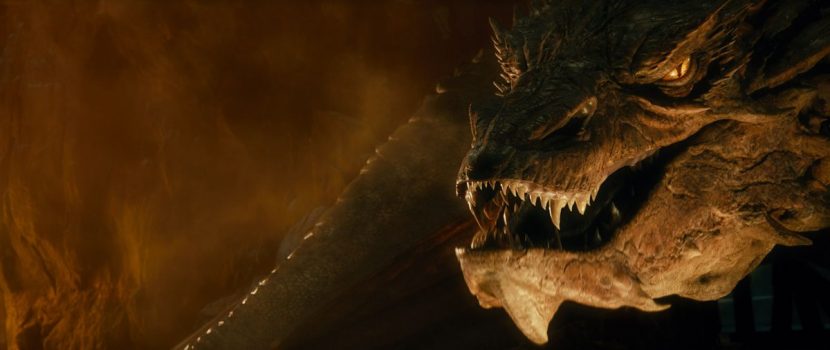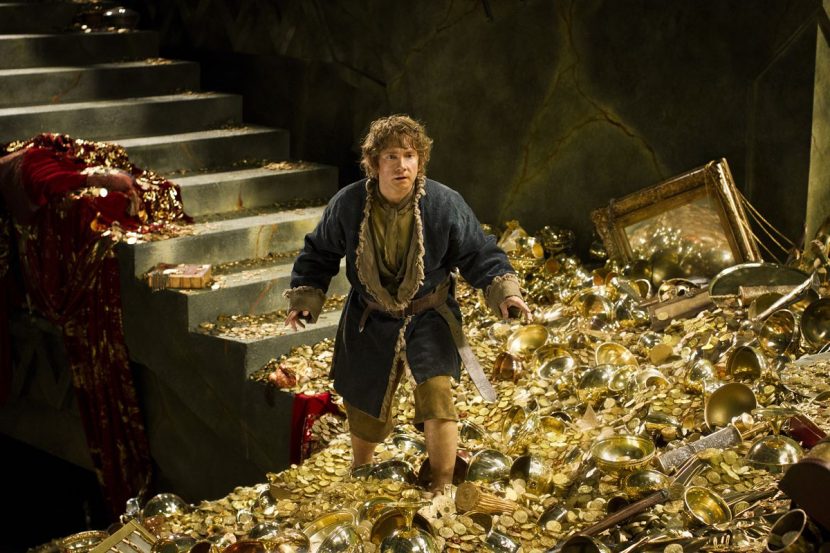Among the many incredible digital creatures and environments in Peter Jackson’s second Hobbit film, one that stands out is, of course, Smaug. Brought to life by the artists at Weta Digital, the dragon features the voice of Benedict Cumberbatch, whose performance was also referenced heavily for the final animation. We explore the creation of Smaug with key members of Weta Digital’s team.
Character in close-up
Notably, Smaug engages with Bilbo Baggins inside the Lonely Mountain amongst the Dwarves’ lost treasure in Erebor. That meant that several dragon scenes were envisaged as heavy dialogue set-ups. “A lot of the characters we’ve done in the past have been human or human-type characters,” says Weta Digital senior visual effects supervisor Joe Letteri, “so a lot of what we worked on with Smaug was to translate the human emotion of his performance, especially starting with Benedict Cumberbatch’s performance and that great voice acting that he did, and to try to make that have a physical presence in this large dragon.”
Above: watch a promo for the film.
“Not only to have a large screen presence, but also those intimate moments with Bilbo because those are just as important when he’s big and scary and overwhelming,” adds Letteri. “We tried to keep everything really forward, and felt much more like a dialogue scene than you would have got otherwise.”
Interestingly, in the first Hobbit film, Weta Digital made a four-legged Smaug with wings on his back to facilitate scenes of the dragon rampaging through villages. But in The Desolation of Smaug, the character had to be able to emote through his hands – which necessitated a return to a two-legged dragon with wings on his arms. Jackson agreed to the change so long as Smaug was fixed on the DVD version of the first film – which Weta Digital did.
Dragon-making
To gather reference for Smaug’s scaly reptilian surface, Weta Digital had to look quite a distance beyond their own backyard. That’s because, according to visual effects supervisor Eric Saindon, there are not many reptiles in New Zealand. “I had to go to Australia Zoo to photograph snakes and iguanas,” he says.
Ultimately, the dragon’s back scales were hard and solid like a tortoise shell, with smaller scales on the belly like snake-skin. Weta Digital looked to build as many individual scales as possible, each being able to interact with each other and fold up realistically. For Smaug’s face, artists referenced crocodiles which typically have stiff and bony areas which are still flesh-like. Textures supervisor Gino Acevedo and his team worked for months to refine Smaug’s final appearance.
King of the Mountain
Although Cumberbatch was filmed with reference cameras and with tracking markers on his face and body, his performance was not strictly motion captured. But how he was delivering lines of dialogue was embraced. “A lot of the animation of Smaug comes more from (Cumberbatch’s) gestures than movement,” Saindon notes.

To translate the vocal performance of Cumberbatch to Smaug’s banter with Bilbo, Weta Digital worked closely on the facial animation set-up. “Peter Jackson wanted to see some lipsync studies,” explains animation supervisor David Clayton. “We got our hands on some footage of Benedict performing as Smaug. What really worked well was using a nose wrinkler. The sneering shape really helped with lipsync. Something that had an ‘ee’ or ‘ah’ – you just engage that nose wrinkler and – bang – it really sells that syllable.”
The heavy dialogue sequences came together firstly as broad animation which was then brought into a mocap stage for Peter Jackson to create virtual camera moves from. Editorial broke the performance down into different shots before final animation took over.
Smaug in 66K
Even before The Desolation of Smaug was released, people were given a rare glimpse of Smaug on the side of an Air New Zealand B777-300 used to help promote the film. VFX supe Eric Saindon was actually behind the enormous 66K render. “That was the biggest render I’ve ever done,” he says. “It was pretty fun to see on the side of a plane. It was about half a terabyte – took a long time to save!”
Animators also paid close attention to give Smaug lots of still moments to make the action more threatening. “Just before he’s about to pounce on Bilbo,” says Saindon, “Pete was, like, cut out all the motion, it would be really threatening. It’ll be chilling. Peter also suggested extra fingers and a thumb onto the wing membrane so he could effectively have hands. It allowed him to negotiate his environment and get into threatening poses – the hands helped tell the story.”
For scenes of Smaug acting aggressively and then in full-flight (Smaug is two 747s in length), Weta Digital looked to large birds. “There’s a scene where Smaug runs and takes off and we used an albatross for reference,” says Saindon. “When they take off they do this run thing. They look terrible when they take off but when they’re gliding they look amazing. We did the same sort of idea for the dragon. He was very elegant flying through the air.”
Treasure-trove of effects
As he chats to Bilbo, Smaug is surrounded by piles and piles of treasure, including mountains of gold coins. Production filmed a small partial area using art department coins on a greenscreen stage with Martin Freeman. The coins were ultimately replaced by Weta Digital – to the tune of 200 billion pieces of treasure – via a new rigid-body solver that aided in gold and Smaug interaction. The biggest shot the studio rendered involved around 20 million coins.
Animators had the benefit of being able to interact directly with the gold coins too. “The guys came up with a plugin that allowed us to make the gold surface a live deformer in our scenes,” outlines Clayton. “It would preserve its volume so if Smaug pushed through it, it would displace gold from one position to another. It allowed animators to be aware of the compositional position of gold.”
In his tussle with Bilbo and the Dwarves, Smaug also unleashes his fiery weapon. In early tests, Weta Digital attempted to have the fire emit directly from the dragon’s mouth. But as it was a fire sim, the effect did not look convincing once it had traveled around 20 to 30 meters from the mouth. So instead they adopted a more ‘fire hose’ approach. “We used a fluid system to emit fluid directly from the dragon’s mouth,” says Saindon, “and then did a solve for that fluid being emitted and splatting on the wall, and then ignited that fluid. So we have super high res detail from the fire, lots of detail and interaction.”
Sitting Smaug in the scene
Weta Digital relied on its physically-based lighting setup within RenderMan to render Smaug, using almost strictly a raytracing approach. Saindon says a lot of the final look benefited from indirect lighting from the treasure. “We got lots of nice gold lighting bounce,” he says, also noting the manner in which Smaug moves between pillars underground. “That played as moody monster lighting. Pete wanted to play a very film noir look on this one.”

As pioneers of deep compositing, the studio also used that approach within NUKE to sit Smaug in the cavernous and constantly moving gold coin environment. “We do everything with deep compositing,” states Saindon. “We don’t do mattes. It’s brilliant – it’s changed the way we do things. I can’t even imagine doing anything without deep composting.”
“It allowed us to do other things as well,” adds Saindon. “In the forges we’re able to bring in a light in the compositing and cast shadows into the deep data. We can do a volume in the forges area and cast shadows in the volume so we can get interactive shadows in the atmosphere at the compositing stage. It gives you a lot of flexibility at the compositing stage.”
All images and clips copyright 2013 Warner Bros Pictures.

[…] terrible to behold, but the entire movie was a visual smorgasbord. How did the visual effects team create literature’s most iconic fire-breathing dragon? Let’s find […]